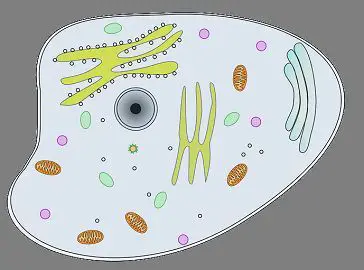Presence or absence of the nucleus is the main difference between cell’s cytoplasm and protoplasm. As cytoplasm does not have the nucleus, which is present in the protoplasm. Even the cytoplasm consists of the organelles like mitochondria, Golgi body, endoplasmic reticulum, etc., on the other hand, protoplasm consists of the cytoplasm, nucleus, and the plasma membrane.
Although, both cytoplasm and protoplasm contain the same chemical constituents such as salts, proteins, and water. The above description was for the eukaryotes, but in prokaryotes where there is no distinct nucleus and other cell organelles, the cytoplasm itself contains the chromatin and protect the genetic material by behaving as the nucleoplasm.
We all are aware of the importance of cell, as it is considered to be responsible for the existence of life. Also, all types of the cell contain three things in common, which are cell membrane, cytoplasm, and genetic material.
Apart from these, there are many other vital parts, contained in the cell and one of them is protoplasm. Although many considered protoplasm and cytoplasm equivalent, in actual there is a variance in both the terms. Therefore, in this article, we will be considering the point on which the cytoplasm and protoplasm differentiate.
Content: Cytoplasm Vs Protoplasm
Comparison Chart
| Basis for Comparison | Cytoplasm | Protoplasm |
|---|---|---|
| Meaning | The semi-solid material, present netween the nucleus and the cell membrane. Mainly made up of water and is responsible for the half of the cell's volume. | Protoplasm is called as the living substance of the cell, and it surrounds the cell membrane, the nucleus and the cytoplasm. So we can say protoplasm constitute the cytoplasm as well as the nucleus. |
| Structural difference | Cytoplasm contains organelles like Golgi body, Endoplasmic reticulum, Mitochondria, Ribosomes, Lysosomes, etc., but not the nucleus. | Protoplasm contains cytoplasm as well as the nucleus; thus we can say that protoplasm = nucleus + cytoplasm. |
| It contains | Cytoplasm is one of the constituents of the protoplasm, it is jelly like fluid and contains water, metabolic wastes, proteins, food reserves. | Protoplasm is thick, viscous fluid which is translucent and is made up of proteins, lipids, carbohydrates, nucleic acid and inorganic salts. It is the site for various biological and chemical activities. |
Definition of Cytoplasm
The word was coined by the ‘Rudolf von Kolliker‘ in the year 1863, as the synonym of protoplasm. The term ‘Cyto‘ means cell and ‘Plasm‘ means liquid, so Cytoplasm is the transparent material, percent between the cell membrane and the nucleus of the eukaryotic cell. It is the semi-fluid, translucent material and constitutes all the cell organelles, metabolic wastes, proteins, food reserves.
As different organelles have different functions like mitochondria, which is called the ‘powerhouse of the cell’ is known for producing energy, Golgi is known for protein sorting, endoplasmic reticulum is known for transporting material, cytoskeleton provides the structure and rigidity to the cell and so on. Therefore, these organelles are supported by the cytoplasm to work smoothly and faultlessly.
The cytoplasm also surrounds the nucleus. It contains the cytosol or cytoplasmic matrix, which is the aqueous substance and is differentiated into outer ectoplasm and inner endoplasm.
Definition of Protoplasm
The word Protoplasm is a Greek word, which means “first thing formed“. It is jelly-like substance, where numerous chemical, as well as biological activities, takes place. Therefore, protoplasm is said as the ‘physical basis for life’ and part of the living cell. It contains about 90% water, salts, proteins, lipids, and carbohydrates. It is selectively permeable, elastic, granular, colloidal, colourless substance.
Protoplasm is said as the living substance of a cell. Although in modern biology protoplasm is not used commonly, as it does not have the full proof origin and so these days only cytoplasm, organelles and nucleus is studied.
Key Differences Between Cytoplasm and Protoplasm
Following critical points which differentiate between the cytoplasm and protoplasm:
- Cytoplasm is the semi-solid material, surrounding the nucleus; it contains the organelles like Mitochondria, Golgi body, Endoplasmic reticulum, ribosomes, etc. It is mainly made up of water and is responsible for the half of the cell’s volume. On the other hand, Protoplasm is called as the living substance of the cell, it is the jelly-like material and surrounds the cell membrane, the nucleus, and the cytoplasm.
- Cytoplasm contains organelles like Golgi body, Mitochondria, Endoplasmic reticulum, Lysosomes, Ribosomes, etc., but not nucleus, but Protoplasm constitutes cytoplasm as well as a nucleus; thus we can say that protoplasm = nucleus + cytoplasm.
Conclusion
So we can conclude that cytoplasm is not different from the protoplasm, rather being a part of it. In fact, nucleus and cytoplasm make the protoplasm. We also found that they contain all the elements same with a little difference.


Leave a Reply